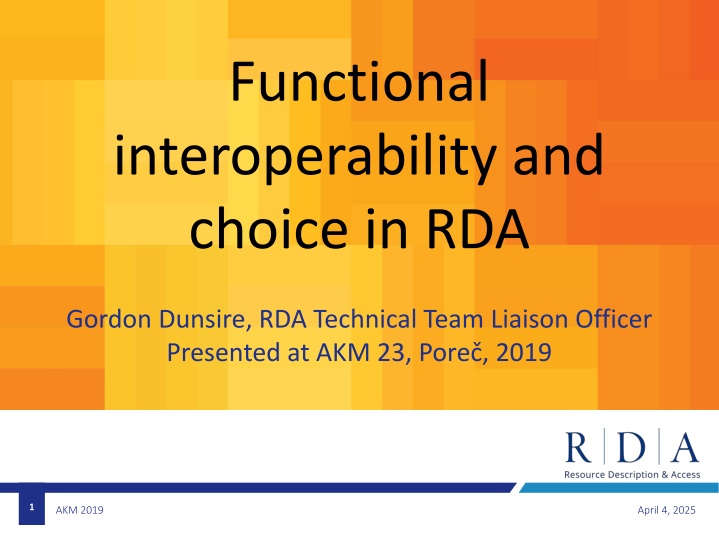
Choice and Interoperability in RDA for Enhanced Metadata Management
Explore the essential aspects of functional interoperability, choice, and consistency within RDA (Resource Description and Access) for effective metadata management. Discover how RDA tools and practices offer a wider range of options for organizing and describing information, ensuring greater flexibility and enhanced user experience. Learn about the importance of maintaining both choice and consistency in element selection, recording methods, and entity representation to achieve global interoperability and seamless data integration.
Download Presentation

Please find below an Image/Link to download the presentation.
The content on the website is provided AS IS for your information and personal use only. It may not be sold, licensed, or shared on other websites without obtaining consent from the author. If you encounter any issues during the download, it is possible that the publisher has removed the file from their server.
You are allowed to download the files provided on this website for personal or commercial use, subject to the condition that they are used lawfully. All files are the property of their respective owners.
The content on the website is provided AS IS for your information and personal use only. It may not be sold, licensed, or shared on other websites without obtaining consent from the author.
E N D
Presentation Transcript
Functional interoperability and choice in RDA Gordon Dunsire, RDA Technical Team Liaison Officer Presented at AKM 23, Pore , 2019 1 AKM 2019 April 4, 2025
3R Project RDA Toolkit Restructure and Redesign Modern responsive design Users of mobile devices Users with sensory preferences RDA content infrastructure Convert to DITA standard Increase re-use of RDA Reference data IFLA Library Reference Model RDA Board strategy 2 AKM 2019 April 4, 2025
Wider community, wider choice 2011: DNB joins RDA governance structure International governance structure for RDA Board strategic markets: International communities Cultural heritage communities Linked data communities 2019: Most RDA tools are optional 3 AKM 2019 April 4, 2025
Choice of agent entities Agent Person Collective Agent Corporate Body Family 4 AKM 2019 April 4, 2025
Choice of elements Example: Item elements 5 AKM 2019 April 4, 2025
Element hierarchies Example: adaptation of work 6 AKM 2019 April 4, 2025
Choice of recording methods Unstructured description Transcriptions, notes, names, etc. Structured description Formatted statements, access points, etc. Identifier Local identifier codes, numbers, etc. IRI (Internationalized Resource Identifier) Global Semantic Web 7 AKM 2019 April 4, 2025
Optional instructions Example: access point for 8 AKM 2019 April 4, 2025
Choice vs Consistency Local values of an element vary naturally (e.g. source), culturally (e.g. language, naming conventions), by policy (e.g. audience), etc. There is no one-size-fits-all RDA entities and elements are consistent with the IFLA Library Reference Model, with coherent semantics Assured levels of global interoperability of RDA metadata Global things described with local strings 9 AKM 2019 April 4, 2025
Application profiles Originally developed by Dublin Core Metadata Initiative 10 AKM 2019 April 4, 2025
Utility of profile Front-end to RDA Toolkit Which choices to take Data input Element + input field Data validation Metadata conformance, quality control, etc. Data extraction What to select from external metadata sources 11 AKM 2019 January 24, 2019
Profile characteristics An application profile typically specifies: The elements to be recorded as a metadata description set for an entity The mandatory and repeatability status of each element The vocabulary encoding scheme to be used as a source of data for an element The string encoding scheme to be used to assemble the data for an element 12 AKM 2019 April 4, 2025
RDA application profile Selects only RDA elements Additional parameters that are unique to RDA: Links to RDA instructions at multiple levels The recording method to be used for an element, where a choice is available The optional instruction to be applied to an element The policy statement to be applied to an element 13 AKM 2019 April 4, 2025
Profile documentation Profile may be documented in various formats From Narrative (unstructured): Record at least one content type taken from the RDA Content Type vocabulary. To Machine-readable: Several linked data vocabularies for profiles available or in development 14 AKM 2019 April 4, 2025
Toolkit notes Simple, unstructured, personal application profile 15 AKM 2019 April 4, 2025
Tabular/template layout Each row specifies a separate element Each column specifies a profile parameter for the element Spreadsheet, word-processor, database Element Element 1 Element 2 Element 3 pA pB pC pD pE pF pG Application notes 16 AKM 2019 April 4, 2025
RIMMF4 17 AKM 2019 April 4, 2025
Conclusion Choice is essential for local applications Global consistency = functional interoperability Based on coherent semantic model(s) Application profiles present a local view on a global landscape 18 AKM 2019 April 4, 2025
Thank you! Questions? 19 AKM 2019 April 4, 2025
